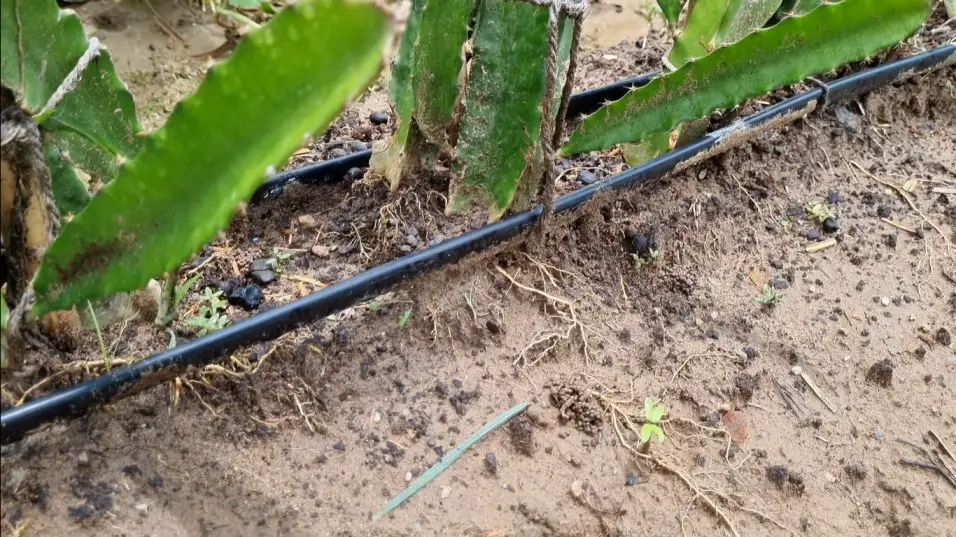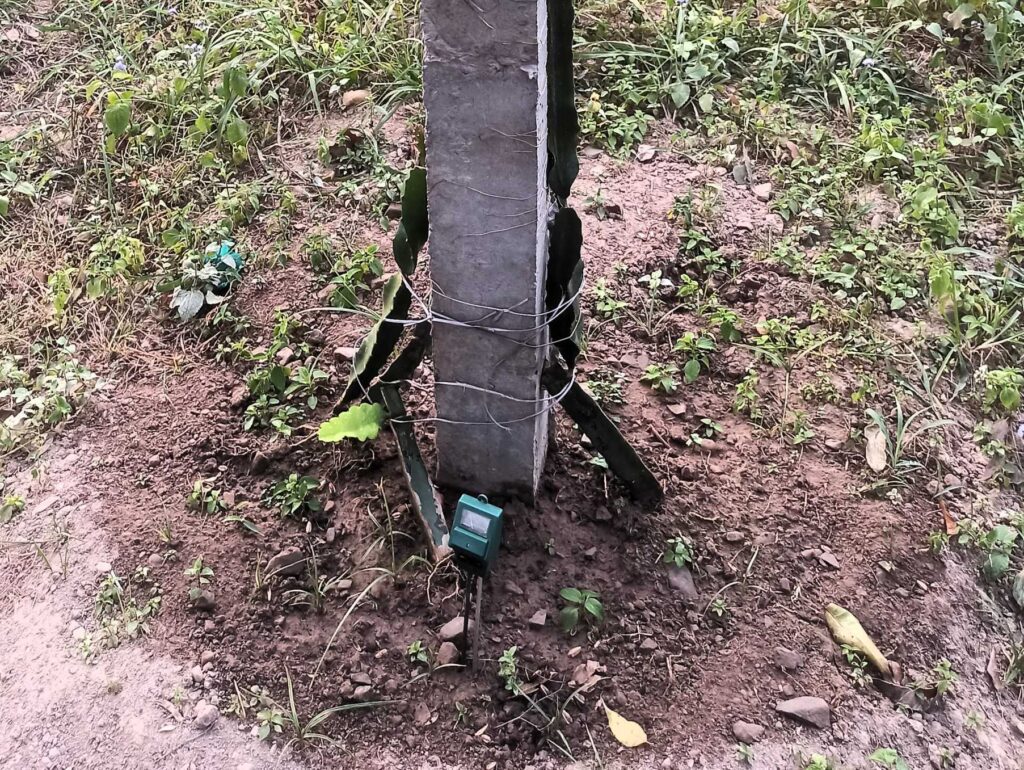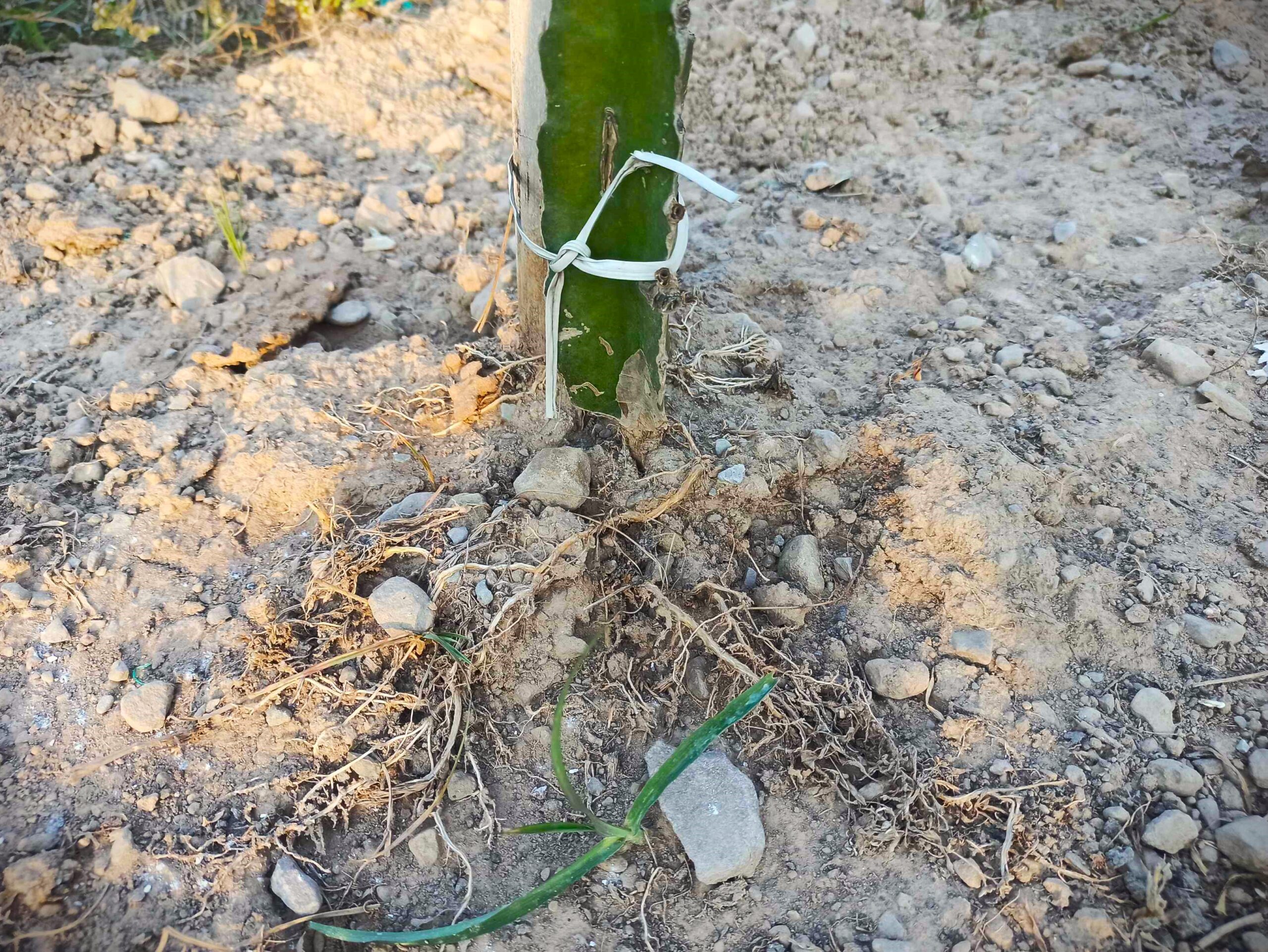Dragon fruit cultivation is gaining significant popularity in India, especially among new and young farmers. However, it is a tricky plant to grow, and many new farmers often struggle to understand common issues related to dragon fruit, such as the roots and their health. Dragon fruit root system is extremely sensitive and one of the most vital parts of the plant. In this article, we will dive into the various aspects of dragon fruit roots, their development, and how you can maintain healthy roots for optimal plant growth and fruit production.
What Are Aerial Roots in Dragon fruit root system?

Aerial roots are roots that grow above the soil, and in the case of the dragon fruit plant, they can sprout from any part of the plant. These roots play a crucial role in supporting the plant’s growth. Typically, aerial roots help the plant in two key ways:
- Providing Stability: As dragon fruit plants grow, they climb and sprawl. Aerial roots help stabilize the plant, preventing it from falling over as it ascends in height.
- Absorbing Moisture and Nutrients: Aerial roots absorb moisture and nutrients directly from the air, which is particularly beneficial during dry conditions when soil moisture may be insufficient.
Aerial roots are essential for the plant’s survival, especially in regions where the soil is dry. These roots enable the plant to “breathe” and absorb the required moisture and nutrients from the atmosphere. In the case of yellow dragon fruit, as the plant climbs higher, the aerial roots play a vital role in supporting its stability and balance.
Understanding dragon fruit roots
In dragon fruit root system the root zone of dragon fruit is incredibly delicate. It typically has a small radius of a few inches, meaning that the roots do not spread out very far. The root zone is sensitive, and if not managed properly, it can hinder the plant’s growth and fruit production.
For successful cultivation, understanding the root zone’s characteristics and taking proper care of it is crucial. The plant needs a structured environment for its roots to develop well. Without proper root management, the plant may struggle to take in the necessary nutrients, leading to poor growth and uneven fruit development.
Root Development in Dragon Fruit

One of the most important aspects of dragon fruit cultivation is ensuring that the dragon fruit roots are healthy from the very start. If the roots are not developed properly during the early stages of plantation, the plant will not grow effectively. For better root growth during plantation, here are a few tips:
- Shade and Medium: Keep the cutting in the shade and use a polybag filled with cocopeat to ensure proper root development. This will help the plant absorb moisture while allowing roots to form naturally.
- Avoid Over-Watering: Over-watering during the early stages can lead to root rot, hindering the plant’s growth. It’s essential to strike a balance in watering.
Healthy dragon fruit root system and its development is the foundation for strong growth. When the roots are healthy, the plant is able to absorb nutrients more efficiently, promoting faster growth and better-quality fruit.
Soil Management for dragon fruit root depth

Dragon fruit requires specific soil conditions for the roots to thrive. dragon fruit root depth Before planting dragon fruit, it’s crucial to test the soil to ensure it has the necessary nutrients. Here’s how you can optimize the soil for dragon fruit growth:
- Soil Structure: Create a proper bed structure for the plants. Adding sand or gravel to the soil will prevent it from becoming too compact, allowing the roots to spread freely.
- Adding Sand for Better Drainage: Mixing sand into the soil ensures that the plant has good drainage. This helps prevent waterlogging, which can damage the roots.
- Fertilization: Adding a pinch of sand along with fertilizer for each plant helps to ensure the plant receives all the nutrients it needs. Sand helps to keep the roots closer to the surface where they can spread out, and it prevents deep root penetration, ensuring the plant remains stable.
Protecting Roots from Damage
The roots of the dragon fruit plant are highly susceptible to damage, and several factors can threaten their health:
- Exposure to Extreme Weather: The roots can get damaged from harsh sunlight, cold weather, or excessive rain.
- Pests and Diseases: The roots are vulnerable to pests like termites and root-knot nematodes.
To protect the dragon fruit roots, many farmers use natural methods such as applying neem cake or mustard cake in the soil. These organic materials help deter pests and prevent root rot. Additionally, mulching around the plant helps protect the roots from harsh weather conditions. It insulates the soil and helps retain moisture, ensuring that the roots remain in a stable environment.
Maintaining Healthy Roots with Proper Fertilization
The roots of the dragon fruit plant require adequate nutrients for growth. Regular fertilization helps ensure that the roots remain healthy and that the plant absorbs the right amount of nutrition.
- Use of Humic Acid: Humic acid is known to improve root health. It strengthens the roots and helps in the absorption of essential nutrients.
- Watering with Nutrient-Rich Solutions: When watering your dragon fruit plant, mix seaweed liquid fertilizer and NPK 19-19-19 into the water. This combination provides the plant with a balanced amount of nutrients that promotes healthy root development.
Tip of the Day: Building a Healthy Root System
For those new to dragon fruit farming, one of the most important things to understand is the balance between proper dragon fruit root depth development and soil management. Here’s a key tip for maintaining a healthy root system:
“Focus on maintaining the right balance between moisture, soil quality, and fertilizer. Make sure the roots stay close to the surface of the soil by using a well-structured bed and adding sand to ensure good drainage. Remember, healthy roots are the foundation for healthy plants.”
To develop this balance:
- Check Soil Drainage: Always test for proper soil drainage. Dragon fruit requires well-drained soil, so it’s essential to monitor the water level in your planting area.
- Use the Right Fertilizers: Using organic fertilizers and ensuring they reach the roots without harming them is critical. Too much fertilizer can lead to root burn, while too little can stunt growth.
- Regular Root Inspection: Periodically inspect the roots for any signs of rot or pest infestation. If you notice yellowing or wilting, it could be a sign of root problems. Remove affected areas and treat them with natural pesticides or fungicides.
Frequently Asked Questions (FAQ)
Q1: How far can the roots of a dragon fruit plant grow?
- Answer: Dragon fruit plants typically have a root zone that extends from 8 inches to a foot in radius. The roots don’t spread far, which is why creating a proper bed structure is essential for their growth.
Q2: What does it mean if the roots of a dragon fruit plant grow upward?
- Answer: If the roots are growing upwards, it indicates that the plant is lacking essential nutrients. This is often a sign that the plant needs more attention and nourishment.
Q3: How can we keep dragon fruit roots strong?
- Answer: Adding phosphorus and humic acid to the soil can help in strengthening the roots. Proper irrigation and the right amount of sunlight also play a significant role.
Q4: Can dragon fruit be grown in clay soil?
- Answer: Yes, dragon fruit can be grown in clay soil, but before planting, you should prepare the soil bed and, if necessary, mix in sand to improve drainage and ensure the roots don’t get waterlogged.
Q5: How do we protect dragon fruit roots from pests?
- Answer: You can protect the roots by using neem cake, mustard cake, and mulching. These natural methods prevent pest infestations and keep the roots safe from harmful insects.
Q6: How often should dragon fruit plants be watered?
- Answer: Dragon fruit plants require moderate watering. It’s essential to ensure the soil is moist but not waterlogged. Over-watering can cause root rot, while under-watering can lead to dehydration.
Q7: How to handle dragon fruit plants during extreme weather conditions?
- Answer: Use mulching and shade netting to protect the plants from extreme heat. During the winter, mulching helps keep the soil temperature stable and protects the roots.
Q8: How can we promote faster root growth in dragon fruit plants?
- Answer: Providing the plants with a nutrient-rich environment, using proper fertilizers, and ensuring adequate water supply can promote faster root growth. Use a balanced NPK fertilizer and seaweed extract for best results.
Q9: Can dragon fruit roots grow in pots or containers?
- Answer: Yes, dragon fruit plants can be grown in containers, but you will need to ensure that the container is deep enough to allow the roots to spread comfortably and the soil drains well.
Q10: Is it important to regularly check dragon fruit roots?
- Answer: Yes, it’s crucial to periodically inspect the roots for signs of pests, diseases, or rot. Early detection can help prevent damage and ensure healthy plant growth.
By understanding the importance of root health and following these practical tips, you can ensure the success of your dragon fruit farming journey. Happy farming!
Also Read: Dragon fruit farming Step 1 Land prepare
Dragon fruit Farming step 2 – Right Structure
Dragon fruit farming step 3 – Water Management


1 thought on “Dragon Fruit Root system: Unlocking the Secrets to Success”